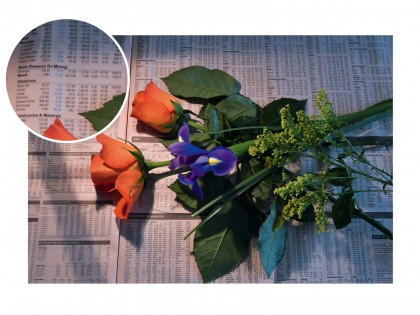Nikon D500 vs Nikon D750: Which DSLR should you choose?
Who really needs a full-frame DSLR?
3. Depth of field
The size of a camera's sensor has a big impact on the depth of field in your photos: the smaller the sensor, the greater the depth of field at a given lens aperture and equivalent focal length. This is a good thing if you're photographing landscapes, still lifes, macro shots or any other kind of photography where you want as much depth of field as possible. It's not so good if you want to make your subject stand out by blurring the background.

As a rule of thumb, DX cameras will effectively give you one f-stop more depth of field than FX ones at a given aperture, assuming you're using an equivalent focal length to allow for the sensor's 'crop factor' and to get the same angle of view.
The larger sensor in FX-format Nikons like the D750 means that you need to use longer focal length lenses to get the same angle of view, and this produces shallower depth of field. In the days of film, when focusing was relatively primitive and photographers relied heavily on 'zone focusing', extra depth of field would have been a bonus.
However, with today's super-sharp lenses and pin-point focusing, photographers can properly exploit their cameras' shallow depth of field effects, creative background blur and beautiful 'bokeh' – and FX Nikons can do this better than DX models.

The differences are subtle. In our sample shots, you have to look quite closely to see that the background in the picture from the D750 is more blurred.
The important thing to remember is that depth of field is not an 'on-off' thing. Sharpness falls away progressively, not all at once. The difference between the D500 and D750 is not the difference between sharp and blurred, but degrees of blur. After a while, though, you do start to notice that this tends to give full-frame shots a bit more spatial 'depth'.
4. Lenses, sensors and image circles

All lenses need to produce an image circle large enough to cover the sensor area. Nikon's DX sensor is smaller than its FX sensor, so it's possible to make smaller, cheaper and lighter lenses specifically for this format. The drawback is that these lenses are little use on FX-format Nikons (except in Nikon's lower-resolution 'crop' mode). Sometimes, though, a DX-format lens is the only option for owners of DX cameras because although you can use FX-format lenses too, their longer focal lengths usually rule them out for everyday and wider-angle photography.
Sign up for breaking news, reviews, opinion, top tech deals, and more.
The larger area of the FX-format sensor in the D750 means that you need lenses with a larger image circle to cover it – in other words, full-frame or FX-format lenses. You can physically mount smaller DX lenses on these cameras, but they must switch to a 'crop' mode that uses a smaller area of the sensor with half as many pixels (actually, rather fewer than half), so this is an emergency measure rather than something you'd want to do every day. The larger image circle easily covers DX sensors too, of course, so you can use FX lenses on DX cameras as well.
DX super-wide zooms: Smaller choice
If you want a super-wide-angle lens for a DX-format Nikon like the D500, you've no choice – you have to get a DX-format lens, typically a 10-24mm zoom, and almost all are variable-aperture 'consumer' lenses.
DX standard Zooms: More for amateurs
Again, the only way to get a useful range of focal lengths in a standard zoom for a DX-format Nikon is with a DX-only lens, typically in the range 18-55mm or 18-105mm. There are some constant-aperture lenses, but the only Nikon one is the old and expensive non-VR 17-55mm f/2.8.
Telephotos: DX has an advantage
With telephotos, though, an FX-format lens makes sense, even on a DX camera. The effective focal length increase is a benefit rather than a drawback, so Nikon's 70-200mm f/2.8 becomes a 105-300mm f/2.8 equivalent – and you can still use it if you switch to an FX-format Nikon later.
FX Super-wide zooms: Better choices
On an FX-format Nikon you need super-wide-angle lenses designed for the bigger sensor size. These weigh more and cost more than their DX equivalents but they are better lenses, including the spectacular Nikon 14-24mm f/2.8 and the VR-equipped 16-35mm f/4.
FX Standard zooms: Better for pros
The standard, or 'kit' lens on a DX-format Nikon will typically offer a wider zoom range but a variable maximum aperture. If you want a constant-aperture lens, the FX format offers more choice – Nikon makes an older 24-70mm f/2.8 and a newer VR version.
Telephotos: Good but expensive
This is one lens type that works just as well on both FX-format Nikons like the D750 and DX models like the D500. The difference is that the crop factor of the smaller DX sensor gives lenses an effective 1.5x magnification, so here's one instance where the DX format offers a bonus.
Current page: D500 vs D750: Depth of field
Prev Page D500 vs D750: Pros and cons Next Page D500 vs D750: Autofocus
Rod is an independent photographer and photography journalist with more than 30 years' experience. He's previously worked as Head of Testing for Future’s photography magazines, including Digital Camera, N-Photo, PhotoPlus, Professional Photography, Photography Week and Practical Photoshop, and as Reviews Editor on Digital Camera World.